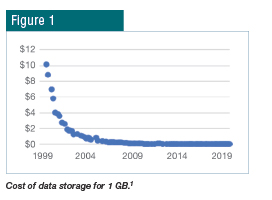DIGITALIZATION — WHY NOW?
 | Most of the technologies that comprise digitalization are not new. In fact, some, such as artificial intelligence and autonomous robotics, have been around for many decades. So, the question is why are companies now embracing and investing in digitalization technologies? These technologies often require vast amounts of data, are computation-intensive and require complex algorithms. Until recent years this has presented significant cost and long computation times to deliver results from complex algorithms. Much has changed regarding data, computation and advanced algorithms, making it possible to solve complex problems more cost-effectively and in near real time. DATAData is a key component to all digitalization technologies. Whether it be for analytical computations, simulation, additive manufacturing, etc., data is the backbone for these technologies, and the landscape of data has changed in many ways over time. This includes lower cost, faster access, larger volumes, wider range of data types (video, sound, etc.), higher quality and greater accessibility (expanded connectivity). A simple way to state this is that the cost of storing data has gone down, thus allowing for more data to be stored, including more complex data, and being able to retain it for longer periods. Between 1999 and 2019, the cost of 1 GB of data storage went from approximately US$8.00 to US$0.02 (US$0.09 to US$0.02 in the last 10 years).1 In addition, with cloud storage options, a company can effectively rent storage without having to make an initial infrastructure investment. COMPUTATIONOne measurement of a computer processor is instructions per second (IPS). The number of IPS for typical computers has continuously increased over the years. In addition, the number of cores for processors has increased along with the number of processors in a computer, thus increasing the total number of IPS a computer can complete. However, what has really revolutionized high-performance computing is the development of high-performance graphics cards for video processing. These video processors contain graphics processor units (GPUs). These GPUs have many cores and can conduct thousands of operations at once in parallel. While they were developed for graphics, they are used today to speed up the processing for solving complex problems in shorter times. What once took days or longer can be done in hours, minutes or even seconds. Last, companies can send their data to a cloud service and rent time on a supercomputer to solve complex problems quickly without investing in computing infrastructure. Models can then be developed from the results that can run on-site.
One of the hurdles for running complex analytical algorithms has been the amount of processing time it takes to run the analytics. The combination of increased data capabilities and processing allows for more complex algorithms to be run in a timely manner. Therefore, the algorithms have been allowed to become even more complex, improving machine learning, artificial intelligence, analytics, simulation models, etc. SUMMARYThe technological advancements and reduced cost in data storage, computer processing, cloud services and more advanced algorithms have greatly enabled digitalization technologies to become a reality for the steel industry. The technology is ready, the costs are feasible and the opportunities to solve more complex problems are abundant.
| ||
AUTHOR | |||
| James Hendrickson | ||



